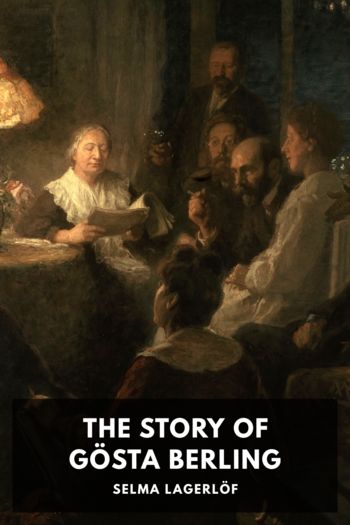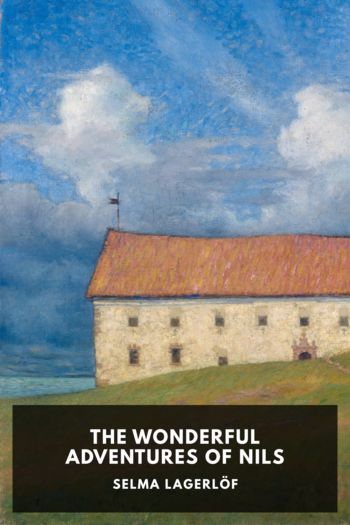The Story of Gösta Berling by Selma Lagerlöf (readnow txt) 📕

Description
Set in the 1820s in central Sweden, The Story of Gösta Berling follows the saga of the titular character as he falls from the priesthood and is rescued by the owner of a local estate. Joining the other saved souls in the pensioners’ wing of the mansion, he embarks upon a series of larger-than-life stories that tell of adventure, revelry, romance and sadness.
Gösta Berling was the eventual Nobel Prize winner Selma Lagerlöf’s first published novel, and was written as an entry to a magazine competition. The richly detailed landscapes of Värmland were drawn from her own upbringing there, and the local folk tales inspired many of the individual stories in the book. The novel was published in Swedish in 1891; this edition is based on the 1898 English translation by Pauline Bancroft Flach. In 1924 the story was made into a silent film, launching the career of Greta Garbo.
Read free book «The Story of Gösta Berling by Selma Lagerlöf (readnow txt) 📕» - read online or download for free at americanlibrarybooks.com
- Author: Selma Lagerlöf
Read book online «The Story of Gösta Berling by Selma Lagerlöf (readnow txt) 📕». Author - Selma Lagerlöf
“We might have known that the girls had carried him off,” they said; “otherwise we should have had him back here several hours earlier.” For the pensioners remembered that this was exactly the seventeenth time Patron Julius had tried to leave Ekeby, once for every departing year. Now Patron Julius had already forgotten both this attempt and all the others. His conscience slept once more its yearlong sleep.
He was a doughty man, Patron Julius. He was light in the dance, gay at the card-table. Pen, pencil, and fiddle-bow lay equally well in his hand. He had an easily moved heart, fair words on his tongue, a throat full of songs. But what would have been the good of all that if he had not possessed a conscience, which made itself be felt only once a year, like the dragonflies, which free themselves from the gloomy depths and take wings to live only a few hours in the light of day and in the glory of the sun?
XI The Plaster SaintsSvartsjö church is white both outside and in: the walls are white, the pulpit, the seats, the galleries, the roof, the window-sashes, the altar-cloth—everything is white. In Svartsjö church are no decorations, no pictures, no coats of arms. Over the altar stands only a wooden cross with a white linen cloth. But it was not always so. Once the roof was covered with paintings, and many colored images of stone and plaster stood in that house of God.
Once, many years ago, an artist in Svartsjö had stood and watched the summer sky and the path of the clouds across the sun. He had seen those white, shining clouds, which in the morning float low on the horizon, pile themselves up higher and higher and raise themselves to storm the heavens. They set up sails like ships. They raised standards like warriors. They encroached on the whole sky. They placed themselves before the sun, those growing monsters, and took on wonderful shapes. There was a devouring lion; it changed into a powdered lady. There was a giant with outstretched arms; he laid himself down as a dreaming sphinx. Some adorned their white nakedness with gold-bordered mantles; others spread rouge over snowy cheeks. There were plains. There were forests. There were walled castles with high towers. The white clouds were lords of the summer sky. They filled the whole blue arch. They reached up to the sun and hid it.
“Oh, how beautiful,” thought the gentle artist, “if the longing spirits could climb up on those towering mountains and be carried on those rocking ships ever higher and higher upwards!”
And all at once he understood that the white clouds were the vessels on which the souls of the blessed were carried.
He saw them there. They stood on the gliding masses with lilies in their hands and golden crowns on their heads. Space echoed with their song. Angels circled down on broad, strong wings to meet them. Oh, what a host there were! As the clouds spread out, more and more were visible. They lay on the cloud-beds like water-lilies on a pond; they adorned them, as lilies adorn the meadow. Cloud after cloud rolled up. And all were filled with heavenly hosts in armor of silver, of immortal singers in purple-bordered mantles.
That artist had afterwards painted the roof in the Svartsjö church. He had wished to reproduce there the mounting clouds of the summer day, which bore the blessed to the kingdom of heaven. The hand which had guided the pencil had been strong, but also rather stiff, so that the clouds resembled more the curling locks of a full-bottomed wig than mountains of soft mist. And the form the holy ones had taken for the painter’s fancy he was not able to give them again, but instead clothed them in long, red cloaks, and stiff bishops’ mitres, or in black robes with stiff ruffles. He had given them big heads and small bodies, and he had provided them with handkerchiefs and prayer-books. Latin sentences flew out of their mouths; and for them whom he meant to be the greatest, he had constructed solid wooden chairs on the backs of the clouds, so that they could be carried sitting comfortably to the everlasting life.
But everyone knew that spirits and angels had never shown themselves to the poor artist, and so they were not much surprised that he had not been able to give them celestial beauty. The good master’s pious work had seemed to many wonderfully fine, and much holy emotion had it wakened. It would have been worthy to have been looked at by our eyes as well.
But during the pensioners’ year, Count Dohna had the whole church whitewashed. Then the paintings on the roof were destroyed. And all the plaster saints were also taken away.
Alas! the plaster saints!
There was a Saint Olof with crown on helm, an axe in his hand, and a kneeling giant under his feet; on the pulpit was a Judith in a red jacket and blue skirt, with a sword in one hand and an hourglass in the other—instead of the Assyrian general’s head; there was a mysterious Queen of Sheba in a blue jacket and red skirt, with a webfoot on one leg and her hands full of Sibylline books; there was a gray Saint Göran lying alone on a bench in the choir, for both horse and dragon had been broken away; there was Saint Christopher with the flowering staff, and Saint Erik with sceptre and axe, dressed in a flowing brocaded cloak.
These saints were always losing their sceptres or their ears or hands and had to be mended and cleaned. The congregation wearied of it, and longed to be rid of them. But the peasants would never have done the saints any injury if Count Henrik Dohna had not existed. It was he who had them taken away.
When Count





Comments (0)